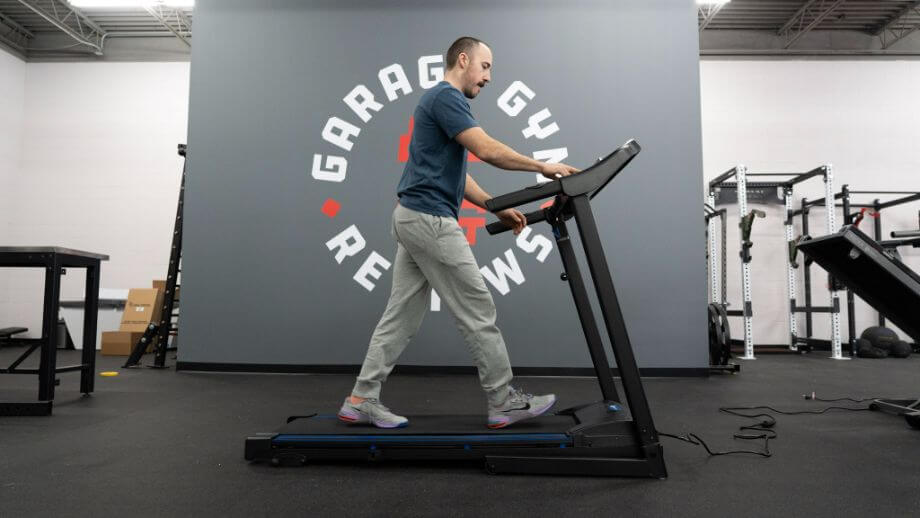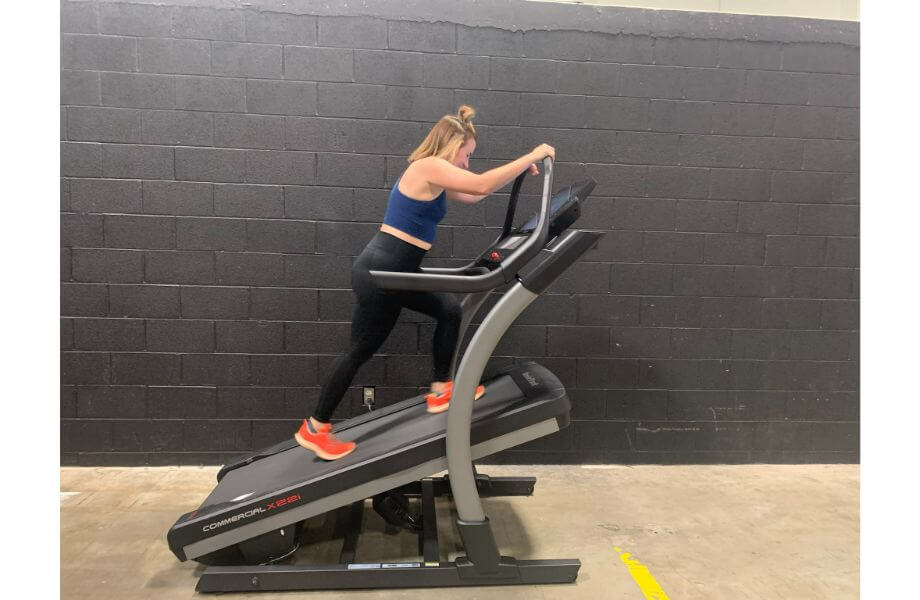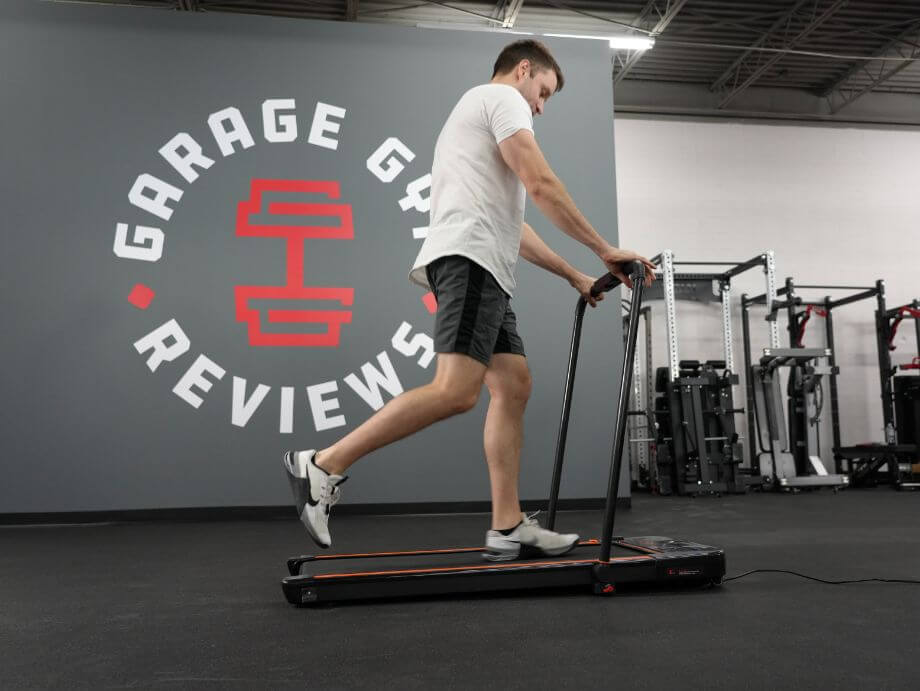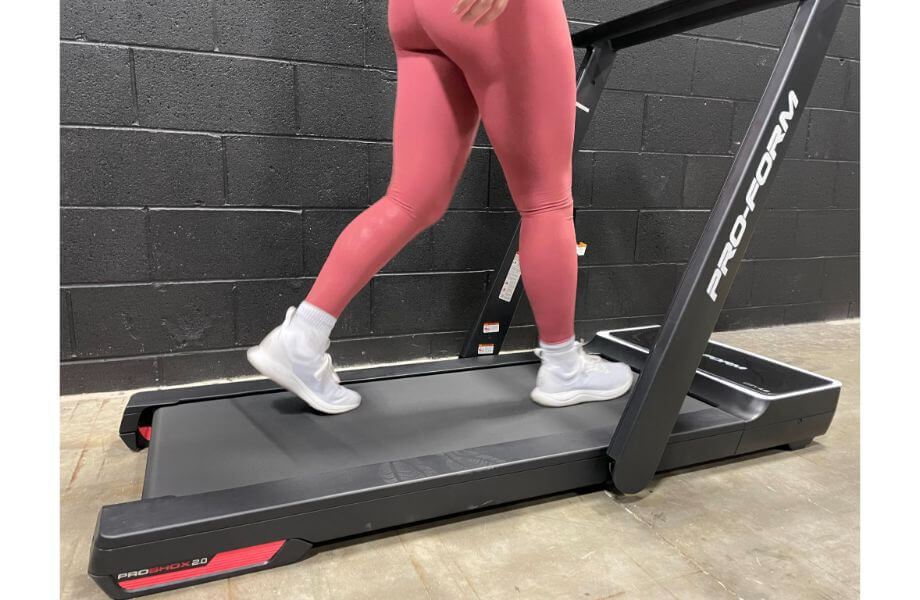We test and review fitness products based on an independent, multi-point methodology. If you use our links to purchase something, we may earn a commission. Read our disclosures.
Whether you want to lose weight, improve your heart health, or simply take a walk to escape the day’s chaos, walking on a treadmill can be a great addition to your workout routine. Treadmill walking offers several benefits to your overall wellness, but you might wonder, “How long should I walk on a treadmill to maximize those benefits?”
The answer to that question really depends on your goals and fitness level. Walking on a treadmill can serve many different purposes, but not all workouts are built the same. Treadmill walking can come in the form of steady-state cardio, incline work, or even high-intensity interval training. Each type of workout is unique, and will provide unique benefits.
You know we talk the talk, but we also walk the walk, so in this article—with an assist from Kate Meier, NASM-CPT, USAW-L1, CF-L1, and GGR head of content—we’ll cut straight to the chase and let you know how long you should walk on a treadmill.
Let’s get walking.
Benefits of Treadmill Walking
Treadmill workouts are a great way to get your cardio in, and they offer many health benefits, both physical and mental.
Treadmill walking can help with:
- Weight maintenance: While nutrition plays an integral role in weight loss goals, aerobic exercise like walking can help support those goals.
- Heart disease prevention: According to a 2010 meta-analysis in the journal Current Opinion in Cardiology1, walking has the potential to play an integral part in the prevention of cardiovascular disease through improving blood pressure and cholesterol, as well as promoting better body composition.
- Aerobic exercise has also been shown to improve mental health markers. If you’re a practitioner of the “Hot Girl Walk” TikTok trend, you know this to be true.
You name the health benefit, treadmill walking can most likely help you achieve it. Walking on the treadmill can help people of all fitness backgrounds reach their goals.
RELATED: Is walking the Best Cardio?

Types of Treadmill Walking Workouts
The cool thing about treadmills? That one piece of equipment can get your heart rate going in more ways than one. If someone tells you they get bored on a treadmill, they may need to switch things up!
Treadmills can serve you for all kinds of workouts, including steady-state, incline, and HIIT workouts. You might have a favorite type of treadmill workout, but each can play a role in a balanced exercise routine. We asked Kate Meier, NASM-CPT, USAW-L1, CF-L1, to help us break down each category.
RELATED: Best Incline Treadmills
Let’s check them out.
Steady-State Workouts
- Type of exercise: Steady-state cardio is simply a workout requiring continuous, steady effort. Once you reach your target speed or heart rate, you stay there for the duration of your workout.
- Intensity: Steady-state cardio is a lower-intensity form of exercise.
- Duration: Move at a consistent pace that will last anywhere from around 15 to 20 minutes for beginners and significantly longer for more experienced endurance athletes.
- Frequency: How often you engage in steady-state cardio depends on your fitness level and goals. Many people can do steady-state cardio workouts, like walking, every day without any negative repercussions. If you’re just starting with steady-state cardio, try two to three workout sessions per week before increasing the frequency.
If physical activity is new to your lifestyle, steady-state walking workout might be a great place to start. It can help support weight loss efforts, increase endurance, and even improve your mood. And while it’s not as low-impact as, say, working out on an exercise bike, walking is fairly joint-friendly.
If you need to clear your mind, steady-state training is a good option, too. It doesn’t take much brain power, and, according to a 2006 study in The Primary Care Companion to The Journal of Clinical Psychiatry2, aerobic exercise like walking has been proven to reduce the symptoms of mental health conditions like anxiety and depression. Just hop on the treadmill, set your speed, and get to stepping. You’ll likely leave the gym in a better mood than when you came in.
Incline Workouts
- Type of exercise: Incline workouts are a type of cardio that targets your lower-body muscles (hello glutes and quads!) and can increase your heart rate even though your pace remains the same.
- Intensity: Incline workouts are fantastic for kicking your typical steady-state cardio up a notch on the intensity factor.
- Duration: If you’re new to incline walking, keep the duration of time you spend going uphill shorter at first. You can start with alternating a minute of incline walking with a minute of flat walking, and gradually increase the time you spend walking uphill while keeping the flat walking the same. Eventually, you can walk on an incline for 20 minutes or longer.
- Frequency: Incline workouts are still low-impact enough that you can do them multiple times a week. Beginners may start with just two days a week and work up to five or more incline workouts each week.”
Using the incline function of your treadmill, you can take the once-flat treadmill deck up and create your own hills. Some people prefer to set the incline (plus speed) and walk until the timer goes off, like the trendy social media “12-3-30 workout“. Others like to create the illusion of rolling hills by increasing and decreasing the incline for set intervals.

No matter your preference, incline workouts are an effective way to boost your fitness level. They can help improve your cardiovascular health, build endurance and stamina, burn calories, and improve your musculoskeletal health.
Walking at an incline activates all the same muscle groups as walking on flat terrain, but it emphasizes your lower posterior muscles. Also, because of the angle, your calves, hamstrings, and glutes will all feel an extra burn compared to walking on a zero incline.
Interval Workouts
- Type of exercise: Interval workouts by definition are workouts that include periods of work and periods of rest.
- Intensity: While you can make these as “easy” as you want, the most effective interval workouts demand that the “work” periods are intense. This makes them some of the highest-intensity cardio workouts you can do with the goal of elevating your heart rate to near-maximal levels for a short period of time and building in rest to allow your heart rate to come down, then repeat.
- Duration: Due to their intense nature, interval workouts typically do not last as long as steady-state cardio workouts. You can get an effective workout in just 10 minutes doing intervals as long as you are pushing the “work” section: For example, if you do four 200-meter sprints with a minute of rest in between, your total workout time could be less than 10 minutes. Frequency: Keep high-intensity interval workouts to just one or two days a week, especially if you’re hitting near-maximal heart rate levels.
Interval workouts, like high-intensity interval training (HIIT), are known for their efficient calorie-burning methods. They involve higher-intensity energy output for a set amount of time (followed by a lower-intensity recovery period.
You can incorporate treadmill walking into a variety of different HIIT workouts. For example, you might choose to walk between sets of treadmill sprints, incline runs, or even between dumbbell work off the treadmill. And, if you’re a beginner, you could alternate between faster intervals of walking and slower intervals of walking for a nice introduction to interval training.
RELATED: Treadmill Dumbbell Workout
Interval workouts can pack a punch. You can reap the same health benefits of other workouts in a shorter amount of time. So especially if you’re on a time crunch, consider an interval walking workout.
How Long Should I Walk?
So, you’re ready to hit the treadmill, but you’re wondering, what’s the optimal amount of time to spend walking? The answer to that question will vary based on your fitness goals. Are you walking to lose weight? To improve your overall health? To clear your mind? The purpose behind your walking can help you figure out how many minutes to spend on the treadmill.
The CDC recommends3 that the average adult gets 150 minutes of moderate-intensity exercise weekly. That’s approximately 30 minutes, five days per week. 2018 research from the journal Obesity4 demonstrated that 35 minutes of walking can help promote weight loss, specifically when divided into bouts of at least 10 minutes of moderate-intensity effort.
A 30-minute steady-state workout is a great place to start when it comes to treadmill walking for weight loss, better physical health, and improved mental health. A lot of good can happen in 30 minutes. If you’re completing an interval workout, you could aim for just 15 or 20 minutes, depending on the intensity.
RELATED: 30 Minute Treadmill Workout
As your strength and endurance improve, you can increase the duration of your workout, or consider implementing interval training. Whether it’s a steady-state walk, incline walk, or interval workout, increasing the challenge of your training by maintaining an elevated heart rate for an extended time can help bring you closer to your goals.
How Fast Should I Walk?
Do you have the need for speed? Increasing your pace can help you meet your goals, but you don’t have to sprint to the finish line for every workout. The goals you set for yourself can help you decide how fast you should push your pace. So just how fast should you walk?
If you’re walking for overall wellness, a leisurely speed will do—you should be able to carry on a conversation with no trouble. (For an average person, that would be about 3 MPH). If you’re aiming for weight loss, a slight increase in pace can help promote calorie exertion—you should still be able to have a conversation, but your breathing may start to increase (For an average person, that would be about 3.5 MPH). And lastly, if your main goal is to improve your aerobic fitness level, kick up the speed even more, to just below a jog.

A certified personal trainer can be a great ally when trying to navigate training decisions to best reach your goals. They can help you develop your treadmill walking program and pair it with strength training workouts.
Expert tip: You might be tempted to hold on to the handrails for extra stability as your speed increases, but taking your arm swing out of the equation goes against the natural way of walking. Avoid holding on to the handrails and maintain good form when on the treadmill.
Treadmill Walking Mistakes
As low-impact as treadmill walking can be, there is still room for mistakes, such as not varying your training enough to prevent boredom or not wearing the proper footwear. We’ve covered this topic in more detail in our guide to common treadmill mistakes and how to prevent them from derailing your cardio sessions.
Walking Away With a Few Final Thoughts
Treadmill walking can be a great way to log your cardio exercise and improve your overall health. Whether you want to burn fat, lose weight, build muscle, or improve your cardiovascular system, spending some time on the treadmill can bring you one step closer to achieving those goals.
Both speed and duration can affect the success you see from your walks on the treadmill.
- Beginners should try for approximately 30 minutes of walking at a moderate pace.
- You can increase the duration of your treadmill walking by 5-minute increments as you develop increased strength and endurance.
- Treadmill walking can be incorporated into your rest days for some low-impact, active recovery.
- Treadmill walking can also be a major component of interval training. You can incorporate brisk walking between rounds of incline or speed work, or spend 15 or 20 minutes doing walking intervals if you’re a beginner.
- If you aren’t sure where to start with your treadmill walking routine, consider working with a certified personal trainer to develop an individualized plan for your specific health and fitness goals.
RELATED: 30 Minute Treadmill Workout
How Long Should I Walk On A Treadmill? FAQs
How long should I walk on a treadmill to lose weight?
According to CDC guidelines2, the average adult needs at least 150 minutes of moderate-intensity activity per week. That averages out to approximately 30 minutes, five days per week. Such a schedule can play a significant role in your weight loss journey. However, when trying to lose body weight, it’s important to remember that a well-balanced diet and strength training can be important additions to walking on a treadmill.
How long should I walk on the treadmill to lose belly fat?
There is no way to burn fat in one specific area, but by walking on the treadmill consistently, you could see a reduction in overall body fat, resulting in reduced belly fat. Starting with the CDC’s recommendation of 150 minutes of moderate-intensity exercise per week could be an effective jumping off point for your weight loss journey.
Is walking on the treadmill 30 minutes a day enough?
According to Harvard Health5, a 150-pound person would burn about 130 calories walking at a 3.5 MPH pace for 30 minutes. Since there are approximately 3,500 calories in one pound, the calorie burn from those 30 minutes (without any calorie restriction or additional exercises) can help you lose one pound over the course of about one month.
How long should I walk on a treadmill just starting out?
If you’re just starting out, you might try walking for approximately 15 to 30 minutes per day at a moderate-intensity walking speed. As you get stronger and your fitness level improves, you can lengthen a couple of your sessions by 15-minute increments. Eventually, you may find yourself walking at a brisk pace for a full 60 minutes.
What is a good speed to walk on a treadmill?
GGR staff writer and certified personal trainer (CPT) Lauren Strong says, “Like any form of exercise, you may need to ease in (or ramp up) to a speed walk. If you’re not accustomed to treadmill exercise, you may need to spend a few workouts (or a few weeks) at lower speeds like 2 or 2.5 mph. One of the main benefits from walking is the cardiovascular benefit. With that in mind, if the speed you’re working with right now gets your heart pumping, that’s a good sign. You can take things a step further and use a heart rate monitor or fitness tracker to ensure you’re walking at a pace that meets your target heart rate.”
References
- Murtagh EM, Murphy MH, Boone-Heinonen J. Walking: the first steps in cardiovascular disease prevention. Curr Opin Cardiol. 2010 Sep;25(5):490-6. doi: 10.1097/HCO.0b013e32833ce972. PMID: 20625280; PMCID: PMC3098122.
- Sharma A, Madaan V, Petty FD. Exercise for mental health. Prim Care Companion J Clin Psychiatry. 2006;8(2):106. doi: 10.4088/pcc.v08n0208a. PMID: 16862239; PMCID: PMC1470658.
- How much physical activity do adults need. Center for Disease Control. June 2, 2023.
- Creasy SA, Lang W, Tate DF, Davis KK, Jakicic JM. Pattern of Daily Steps is Associated with Weight Loss: Secondary Analysis from the Step-Up Randomized Trial. Obesity (Silver Spring). 2018 Jun;26(6):977-984. doi: 10.1002/oby.22171. Epub 2018 Apr 6. PMID: 29633583; PMCID: PMC5970037.
- Calories burned in 30 minutes for people of three different weights. Harvard Health Publishing, Harvard Medical School. March 8, 2021.
Further reading

My Rogue SB-1 Safety Squat Bar Review details why this durable bar needs upgrades to be considered one of the best. Read more

We’ve tried them out through multiple workouts; now read on for our list of the best weightlifting gloves for your next training session. Read more

Increasing your protein intake may offer several health benefits. But what are the high-protein diet side effects? Read more

Are your hammies squealing after Leg Day? We've collected the 7 best hamstring stretches and mobility exercises from a certified personal trainer. Read more

